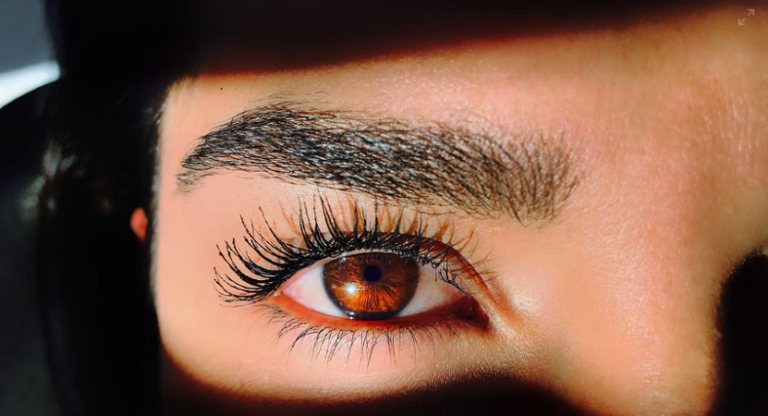These days, it’s almost considered common courtesy to have good brows. Navigating daily life with sturdy, even frames above one’s eye sockets becomes a move of power, and so procedures like microshading are becoming increasingly more popular.
In this article we discuss the following:
- What is Microshading?
- Microshading vs Microblading
- Microshading vs Tattoo
- Microshading Before and After
- Microshading Aftercare
- Microshading Classes
- Microshading Cost
What is Microshading?
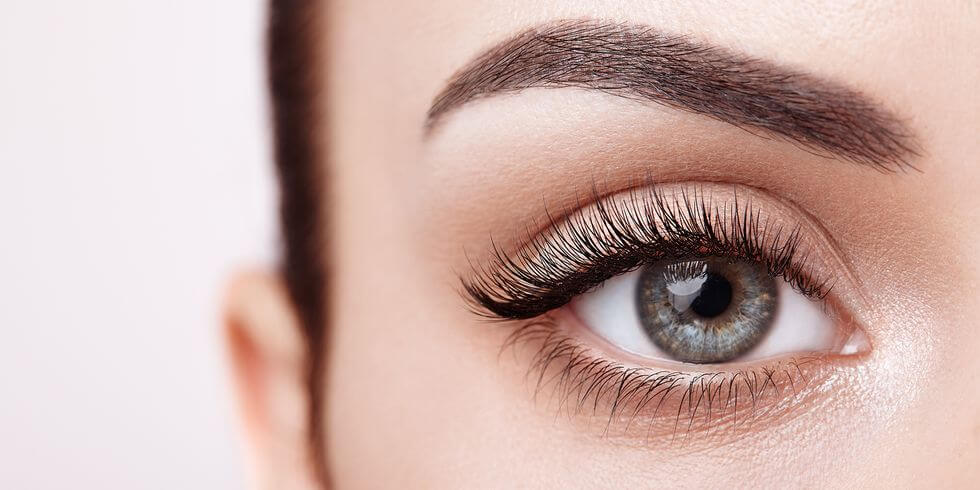
First off, microblading and microshading are not the same thing. Microshading is a cosmetic tattoo procedure that is performed by a skilled technician, similar to that of microblading but not entirely the same.
The goal is to achieve natural looking eyebrow shading that is semi-permanent, and most microshading is achieved via tiny dots that are filled into the brow line by a small, handheld tool containing pigment ink.
This procedure is better suited to individuals who have relatively full brows already, but perhaps exhibit more sparse areas in certain places that need to be given the thickening illusion. It is considered a noninvasive cosmetic procedure with levels of discomfort reaching only slightly higher than that of tweezing or shaving, and nowhere near the pain levels of formal tattooing.
Ombre Microshading
People who seek microshading over microblading generally do so because they are after a very specific makeup look. This technique has the ability to replicate what are known as powder brows.
Powdered brows are achieved through strategically applying brown makeup in such a way that they take on a very structured, ombre look, with sharp outlying edges that blend perfectly into a more subtle tone as they come together in the center of the face.
Ombre brows are very popular at the moment, but not everyone has the time to sit and apply this kind of makeup technique each morning. What’s more, ombre brows are centered around being perfectly mirrored and symmetrical; something that is very tedious to have to tend to on a daily basis, even if one does technically have the time each morning. This is where microshading comes in, offering consumers a procedure that saves them the trouble and the time.
Permanent Eyebrow Shading
Let’s make one thing clear, in the present cosmetic industry, there is no such thing as permanent when it comes to shaded brows. Microshading is a semi-permanent procedure whereby the microshading brows are likely to last anywhere between 1 and 3 years before needing to be redone.
With proper maintenance and regular touchups (which is recommended by all technicians), this time period can be significantly extended without having to undergo the full length procedure.
It wouldn’t be totally incorrect to refer to your shaded brows as permanent makeup for the duration of these 3 years, as you quite literally won’t be able to get the pigment off of your skin during this time, even if you wanted to.
As technology continues to advance in this sector, it’s not unlikely that we are well on our way toward the world’s first actually permanent makeup techniques. Inks, tools and skills are being ever improved in order to offer the consumer the best experience possible. We foresee much improvement and advancement within the microshading world in the coming years — watch this space!
Microshading Machine
A microshading machine is a basic pen-looking device that is easy to hold in just one hand for the duration of the shading process.
The pen is filled with dozens of tiny needles that rotate, very similarly to how a conventional tattoo machine does. The pigment or ink is not inserted into a microshading machine, but rather the head of the device is dipped into the substance before being placed up against the skin surface.
There are many best microshading machines for sale across the internet, but we do express some concern when it comes to this practice as a DIY, at home activity. The technicians who perform microshading are trained professionals, and in some ways, are also artists.
They know where to apply these dots, and at what angle, so that the optimal aesthetic result can be achieved. Buying your own machine to use at home is risky business in that if you misjudge an angle or depth of a dot, you might end up ruining your brows for the next 1 to 3 years.
This is just some caution we would encourage all to consider before jumping at the affordability and accessibility of some of these devices.
Microshading Tools
As mentioned, eyebrow machine shading is ever advancing, and there are now numerous tools on the market that intend to make the shading process more streamlined toward perfection.
Needle attachments of all shapes and sizes are available in shading kits that technicians can acquire when they are ready to take their small business and run with it. Having access to all of these tools will by no means make for a skilled technician, this is something that requires practice, time and dedication.
On the contrary, in fact, some of the best microshading technicians don’t bother with all of the fancy new technology at all. Many are still using the first generation tools that were internal in the development of this practice from the early days.
Microshading tools come in handy when a client has a specific vision in mind that is atypical to what most people tend to want their brows to look and feel like. These tools can be great in achieving the more obvious cosmetic aesthetic, as opposed to the more natural, fuller look that others seek from this process.

Microshading Process
Since your technician is essentially applying a dot shading tattoo, one should go in expecting some sort of experience of pain or discomfort. Many technicians will offer the client some form of numbing cream for their brows that can be applied 30 prior to the start of the procedure.
This numbing cream will have no adverse effects on the ability of the pigment in terms of depth or shade, and won’t shorten the lifespan of the ink either. In other words, it’s totally safe!
What’s wonderful about the microshading process is that there is no downtime. You can quite literally have this procedure done during your lunch break, and return to the office to complete the rest of your day as though nothing invasive had ever occurred.
There are, however, some limitations as to what you can and can’t do to your brows in the days following the shading process. These are tiny wounds, you see, and they do need a bit of time to settle in and heal up before anything too toxic is placed onto them.
We’ll dive deeper into the aftercare for microshading later on in this piece — stay with us!
How to do Eyebrow Shading
Eyebrow procedures are not to be taken lightly, though many individuals on the internet would happily have you believe otherwise. If you do feel particularly called to attempt microshading eyebrows on your own, then here’s how we would recommend tackling this very delicate task.
Firstly, do a lot of research before you begin. Try to learn everything there is to know about what eyebrow skin needs and likes, and if there are angles to your face that you have perhaps never considered aesthetically.
Next, look into the hygienic requirements before attempting this procedure. Ensure that you take every precaution to keep your face and your space sanitary enough for the purpose of shading, which is of course on par with that of tattooing and thus always at risk for viruses such as hepatitis.
When you feel ready and confident that you have the necessary tools, we’d recommend using a well-made Youtube video to guide you through the microshading process from start to finish. There are some great videos on there that are targeted at helping beginners do this procedure on themselves with ease and grace.
Microshading vs Microblading
There isn’t a big difference between microblading and microshading. Shading is a procedure centered around dot-making, while blading is more of a line-oriented technique.
Microshading uses dots to achieve a powdered look that can have an applied makeup look and feel to it, depending on how many dots are inserted. Microblading uses a bladed needle and applies streaks of pigment into the skin that are intended to look like individual hair follicles, creating the illusion of brows where there perhaps aren’t any at all.
Some people need a bit of both, and opt for a microshading and microblading combination. Others think they need one, but soon realize they may be better suited to the other after a little research and possibly a chat with a professional.
Deborah Goldberg is a health and wellness expert with Life Insurance Types. According to her, microshading isn’t always a good option for those who have very oily skin. Since it isn’t very permanent, the pigment will fade more quickly with frequent exposure to oils, eventually becoming blue or pink in places.
Goldberg goes on to mention that microshading is also not covered by insurance, meaning you’ll have to pay out of pocket for it. In the end, it’s essentially just a more expensive version of eyebrow powder, and is likely not worth it for most consumers the way microblading might be.
Microshading vs Tattoo
Yes, there is a difference between microshading and tattooed brows. Both are viable cosmetic options available to consumers who seek fuller, darker brows.
Tattoo artists around the world can technically tattoo “hair” anywhere on the body, and many of them are quite skilled at it as well, despite not having the same training as qualified microshading technicians. This is a form of art, after all, so who better to tackle it than the artists themselves?
Tattooed brows have the simultaneous advantage and disadvantage of lasting forever. This is permanent makeup in every sense of the word, and for some, this is a bit too daunting given how makeup trends seem to fluctuate year by year. For individuals who have perhaps lost their brows totally due to illness or trauma, permanent brow tattooing may be better than microshading or microblading.
Since microshading doesn’t go nearly as deep into the skin as a conventional tattoo, the commitment period is much shorter, and if brow trends to change in the next year or so, it won’t be long before the ink has fallen out and you’re left with a clean canvas to try something new.
Microshading Before and After
Nothing shows the power of great brows quite like a good before and after shot. The following are a series of satisfied customers who have documented their miscroshading journeys for others to see.
We encourage you to keep in mind that no two people are the same, and that even though microshading is a well regulated and streamlined procedure, there is no guarantee that your experience will be as another’s.
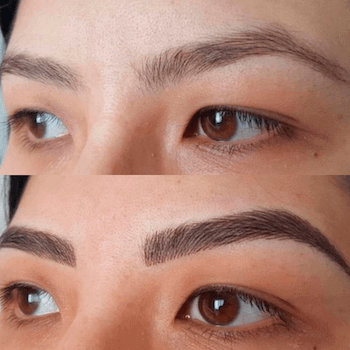
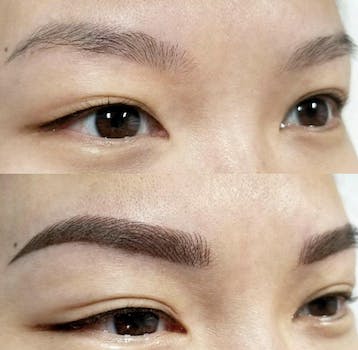
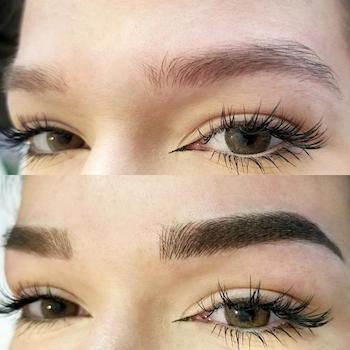
Microshading Aftercare
All cosmetic procedures can be enhanced through simple means of aftercare and general wellbeing. As mentioned, your new brows can last anywhere between 1 to 3 years if proper care procedures are implemented from day one.
Aftercare is something that you and your technician should discuss at length immediately following your successful procedure. Bear in mind, the procedure itself rarely takes longer than about 35 minutes, so at very least, insist on spending a good 10 or so minutes discussing care instructions and getting very clear on what to do/expect.
Microshading Healing Process
As previously stated, there is no downtime to a microshading procedure. There are, however, certain safety measures you’ll want to take so that the needle wounds can heal quickly and safely.
Following your procedure, take care in the washing of your face both morning and night. Be careful when washing around the treated area. It’s important that you be as nonabrasive as possible, and under no circumstance should you rub your face with a towel to dry it or even wipe it down.
There may be an ointment recommended by your technician, which can help to speed up the healing process. Apply it as directed and stick to a fairly scheduled ritual whereby the skin starts to get used to receiving this medicine.
We also recommend taking some time to consider each and every ingredient present in the products that you use on your face on a daily basis. Harsher serums and tonics are best avoided, especially those containing and kind of peeling solutions or bleaching solutions (even natural forms). Chemical products should also be avoided, as they can irritate or cause inflammation in the treated area.
If possible, avoid using makeup in the treated area for at least 10 days post shading. Foundation and brow makeup will only hinder the healing of the region and may also leech harmful toxins into the skin. Keep things really natural and organic for a while — who needs makeup anyway when you’ve got a fresh shade?
How Long Does it Take for Microshading to Heal?
The healing process of microshading is one that unfolds over a period of between 4 to 6 weeks. In this time, the wounds made by the needles will nourish themselves and slowly heal in a way that is non-scarring and risk free.
We’d consider the care instructions listed above fairly vital if you want your brows to be properly healed up come that 6 week mark.
If, after this time, you are still experiencing any kind of redness, irritation or general discomfort, it may be wise to consult with your technician or a healthcare professional. It is possible that you may be having some sort of allergic reaction to the pigment that was used, and that your body is simply having a hard time adjusting to playing host to it.
Ombre Powder Brows Aftercare
Ombre brows have a slightly different aftercare procedure compared to regular microshading. These need more gentle interactions in the days following the procedure as there are zones of very fine shade work, as well as zones of very heavy shade work.
They require very different healing times, so for the most part it is best to have as minimal contact with water as possible for the first few days prior to their application. Ointment is also essential for this style of brow to heal evenly, so take the prescription of your technician relatively seriously.
Microshading Scabbing
Scabbing following a microshading procedure is common and to be expected. These will be tiny scabs that will feel simply like sand is stuck to your face, rather than obvious scabbing that is visible to the naked eye.
Don’t worry, no one in the office is going to know that you had your eyebrows shaded because of deep facial scabbing. Only you’ll be able to feel it.
Try not to rub your brows at all during the scabbing phase, not with your hands nor with a towel/duvet/tissue. This will pull the scabs off prematurely, which means the skin beneath them was not given full opportunity to heal properly.
Similarly, don’t be caught picking at your scabs while zoned out on a business call or lousy Zoom meeting. It can be extremely tempting to do so, but stay alert and allow your face the time and space it needs for these scabs to fall away on their own.
Microshading Classes
Microshading is opening up a world of possibility for people around the world who want to embark on a new, creative career path. The perks are working for yourself (in most cases), having the freedom to work from everywhere, and providing a valuable service to others who get great joy out of their physical appearance being tended to in a professional and careful way.
Microshading classes range between 3 to 10 month courses, and during this time it is relatively easy to become a proficient technician who is ready to take on their first clients immediately thereafter.
It is said that most microshading technicians will totally recoup their course investment within the first 6 months of working in the field.
Microshading Cost
The cost of a microshading procedure is very much dependent on your physical location and how many technicians are available for work in said region. It will also fluctuate depending on your brow needs, with some procedures requiring slightly more specialized skills than others.
On average, a microshading session will cost anywhere between $300 and $1500. Ombre shading tends to cost a bit more than regular filler-shading. Touch ups are generally not included in this package price, and will need to be paid for when the time comes.
At present, microshading is not a procedure that is covered by any kind of medical insurance, so all of these sessions will need to be paid out of your own pocket. It’s definitely an investment; often, it can be beneficial to seek microshading when visiting smaller cities where these kinds of cosmetic treatments are not yet mainstream. You’ll pay far less, and usually for better service and skill.
Microshading Near Me
As mentioned above, it can be lighter on your wallet to seek microshading when you’re traveling, or to drive to a small town near you where the procedure is still relatively niche.
Today, microshading is accessible anywhere and everywhere, with people from all walks of life looking to turn their art into a full time business where they can make their own hours, money and rules.
When it comes to microshading, there is no need to seek out formal establishments. Some of the best microshading technicians work independently and will come to you; you’ll enjoy shading from the comfort of your own home, in many cases.
Microshading studios are uncommon, but many salons and spas might employ an onsite technician who works out of their space, offering the service to the existing list of clientele.
Take time in choosing your microshading technician. Always ask to see their portfolio, and look out for any feedback on their work by previous clients on social media. It’s generally quite easy to tell who is well-loved within the industry, and who is still working out the kinks of their art.
Did You Enjoy This Article?
If you enjoyed this article, you might also like our articles discussing makeup such as Best 10 Organic and Natural Lipsticks, Mica in Makeup, 12 Best Organic, Non-Toxic, and Natural Mascara, Top 15 Zero Waste Makeup and Sustainable Packaging Brands, and Skincare Fridges.


